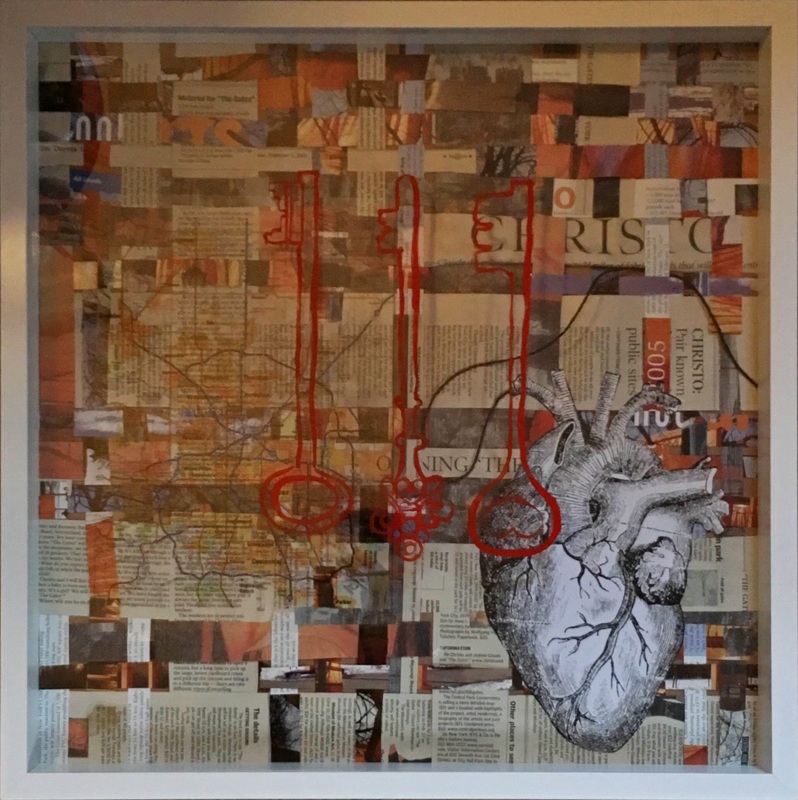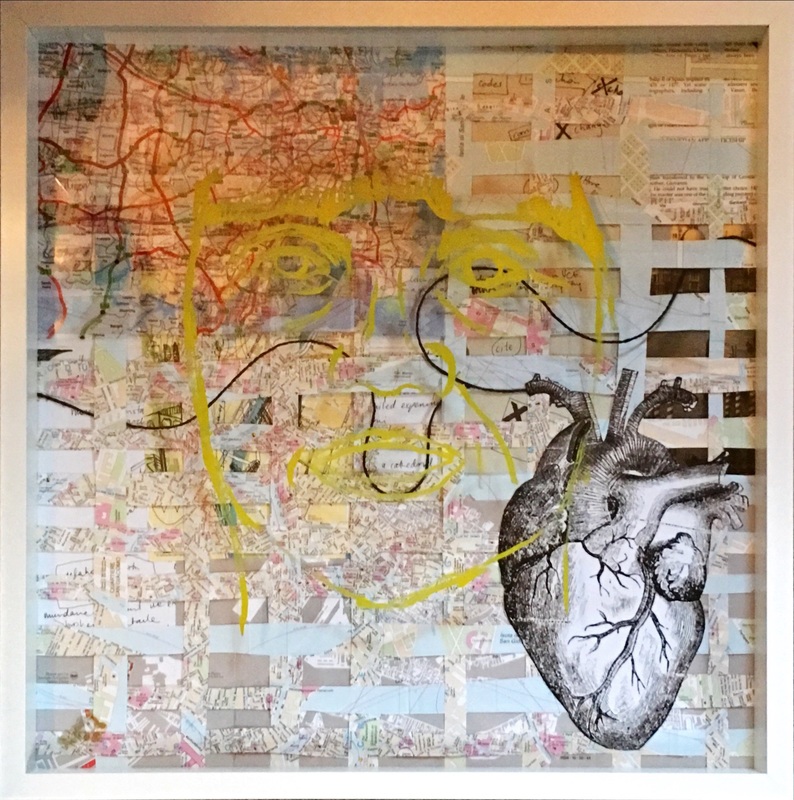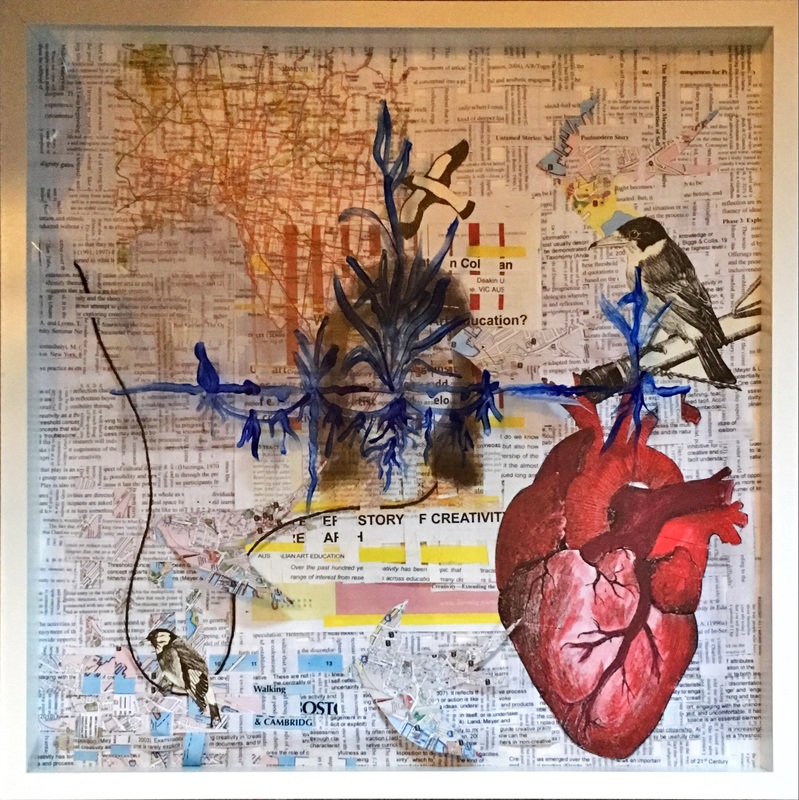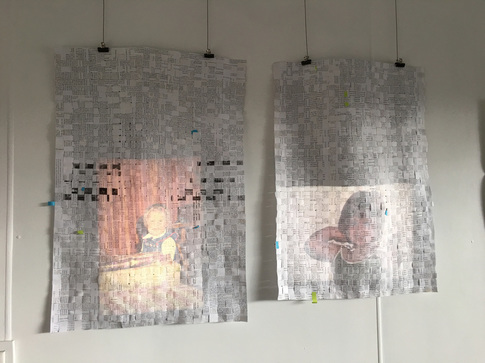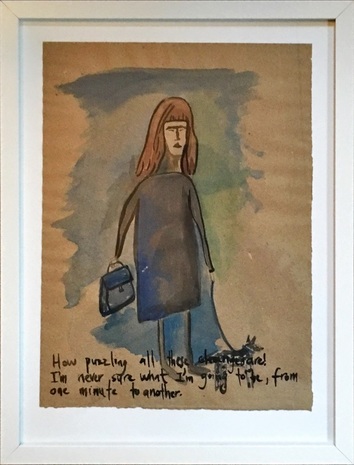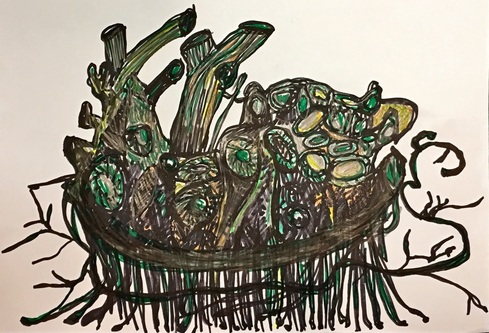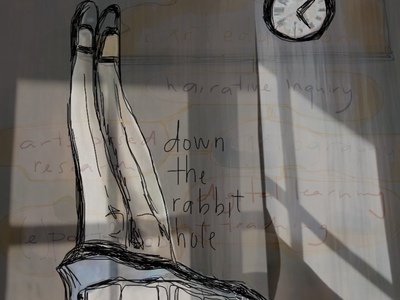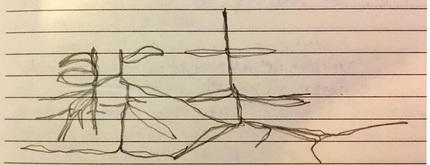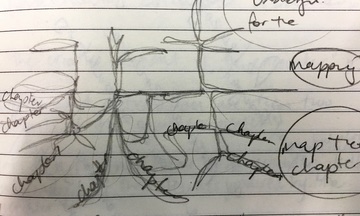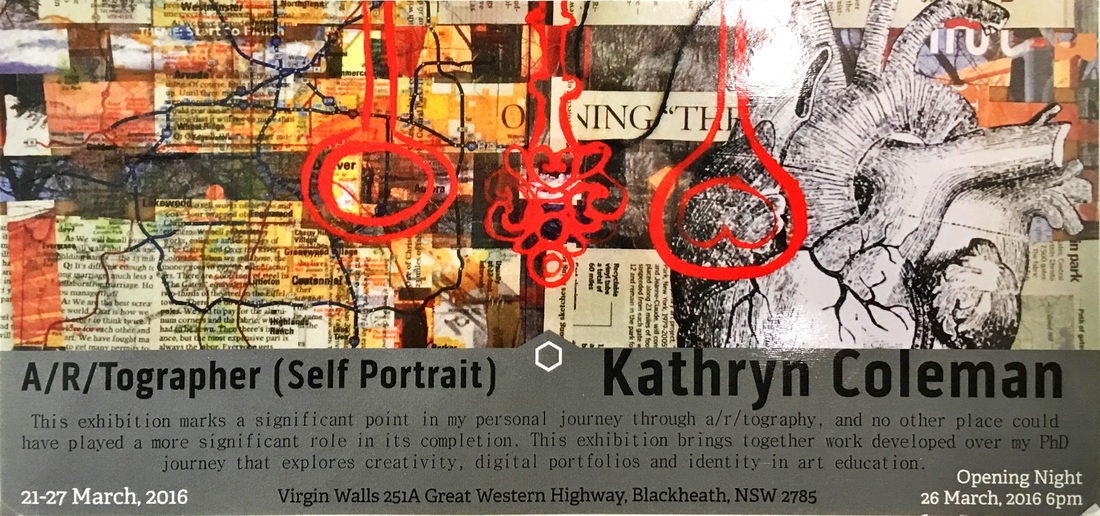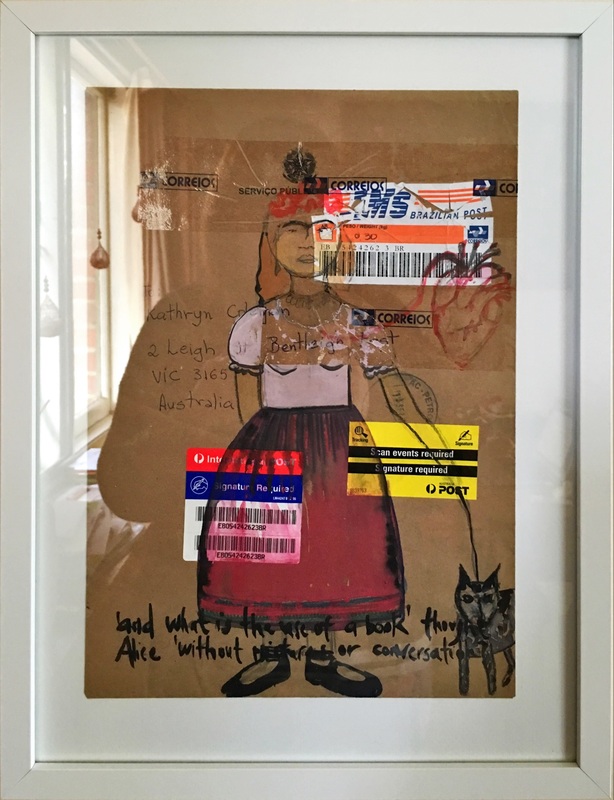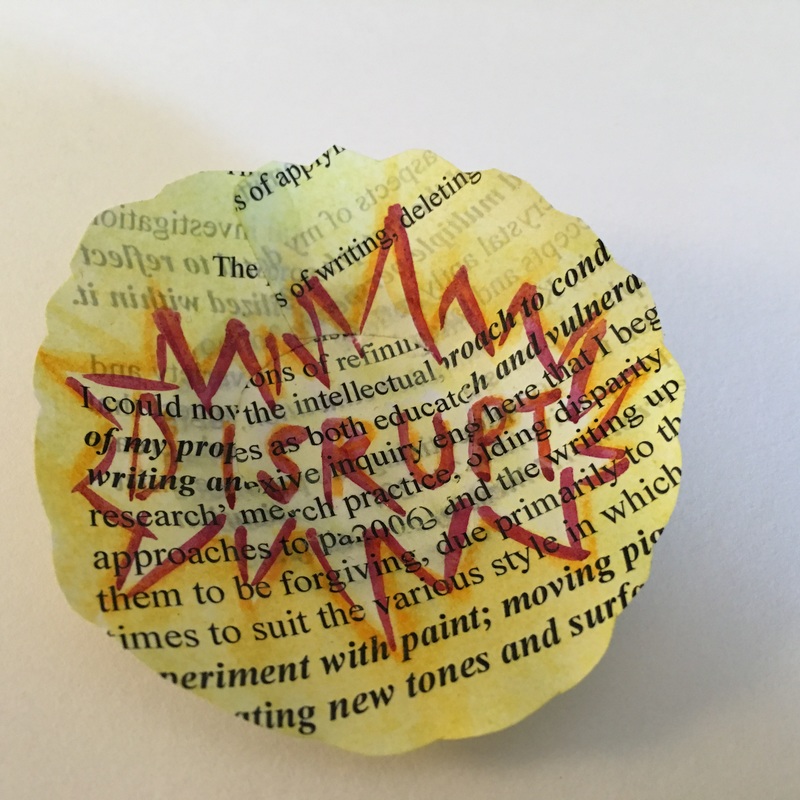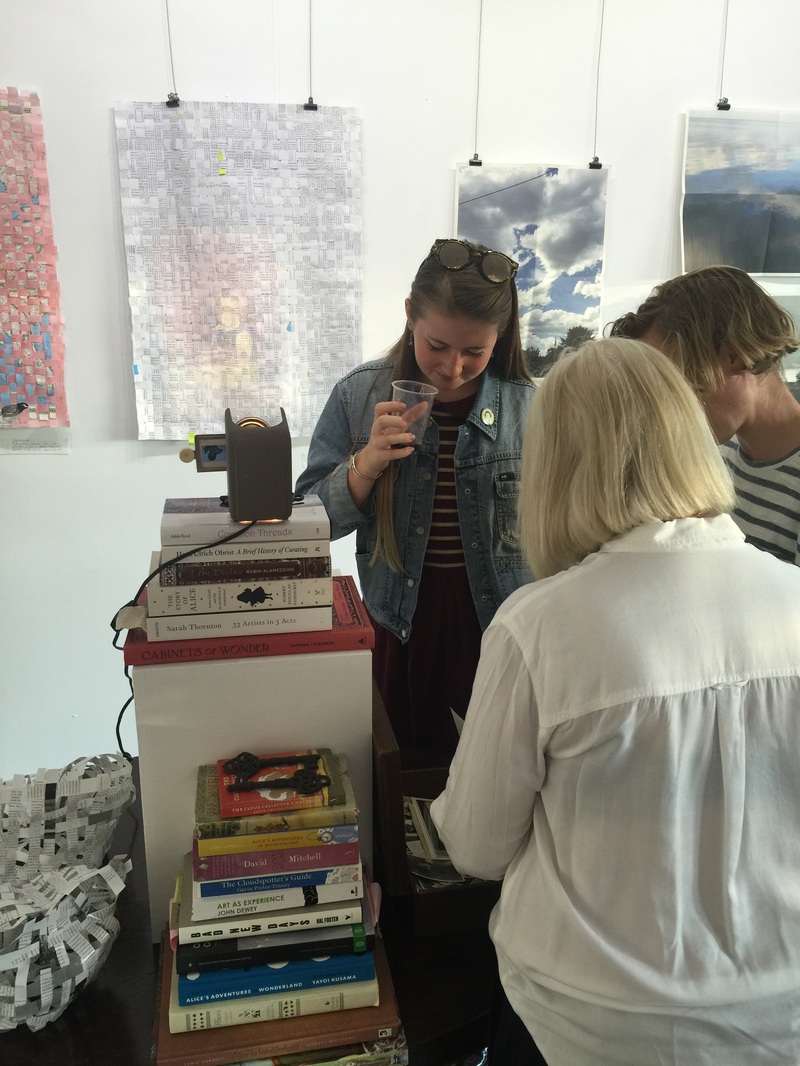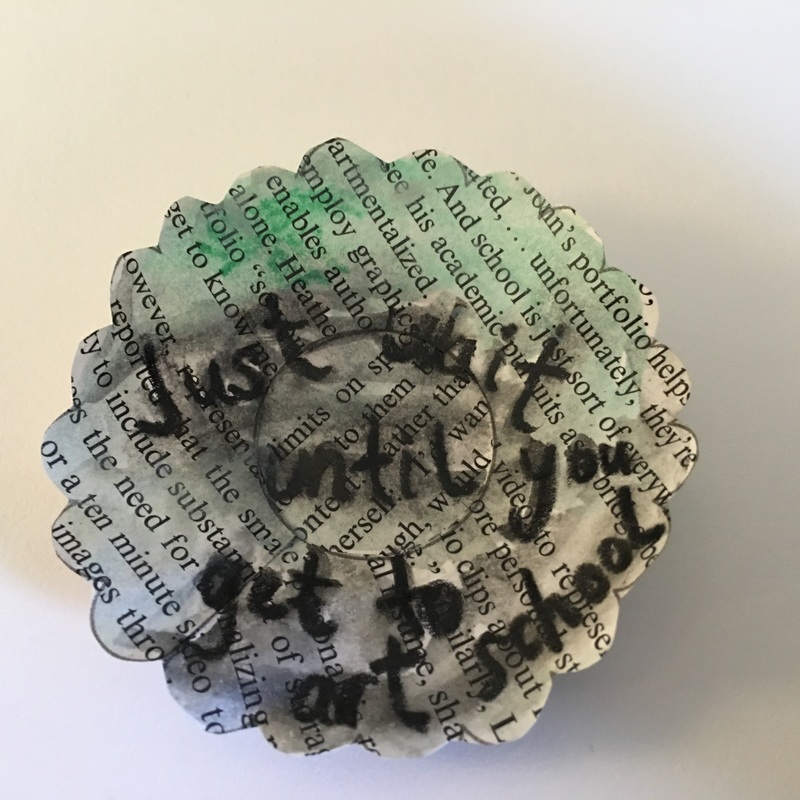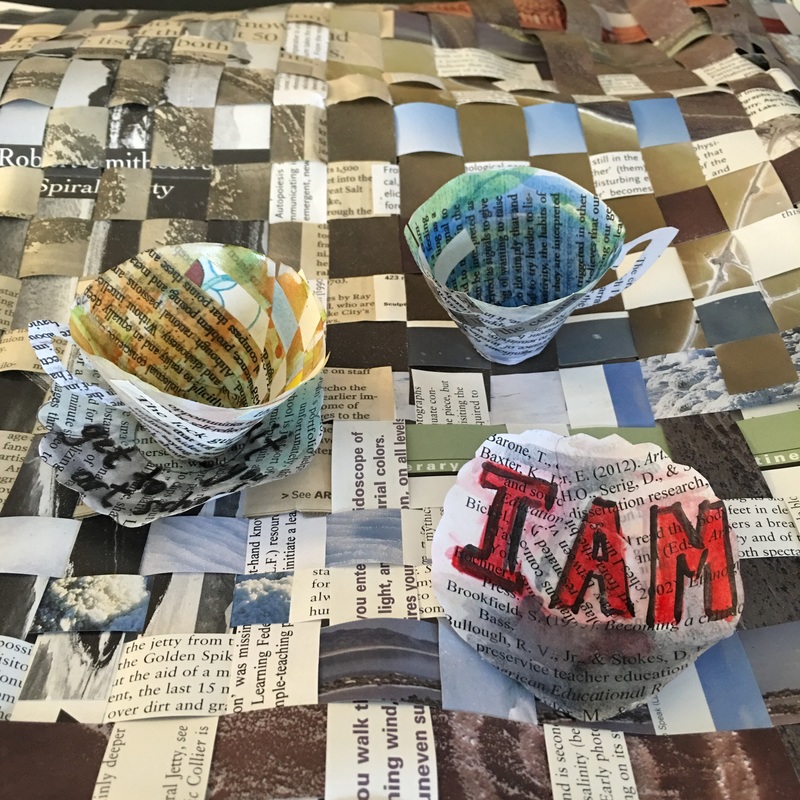Academic Tumbleweeds, Woven selected references & Alice in Wonderland text caught in glass bell jars, 2014 - 2016
A/R/T Statement
Self Portrait (A/R/Tographer) The Three Selves, Woven paper, paint, collage, 2014-2016
Curiouser and curiouser!’ cried Alice (she was so much surprised, that for the moment she quite forgot how to speak good English).
Chapter 2 The Pool of Tears Alice’s Adventures in Wonderland
Chapter 2 The Pool of Tears Alice’s Adventures in Wonderland
"Excess is that which is created when control and regulation disappear and we grapple with what lies outside the acceptable” (Irwin & Springgay, 2008, p.xxx). This excess is a not an overabundance or a lack of moderation rather a gap. In this gap, I find myself in a space that a/r/tography opened. The space is a wonderland of knowing, doing and relating. I am called to make, write and design as a result of a “provocation, calling us to transformation” (Irwin & Springgay, 2008, p.xxx). I would define this provocation as the point of understanding in participatory art and the relationality of contemporary creative practice. Here, I have found creativity in the digital through embodied praxis and knowing. In this A/R/T (artist, researcher, teacher) Portfolio, in a digital and physical living inquiry as digital thesis and PhD study, I have found myself at a tipping point. I am unable to write without making to understand, reading to make and making to write, culminating in curating through reflection for understanding in this Portfolio. Finding myself in the gaps and liminal spaces that a/r/tography and an a/r/tographic living inquiry first awakened for me, I have continued to gaze inwardly. In the gaps now reified between art, research and teaching I found myself in a digital and physical wonderland, a site where participatory art, art education and personalised pedagogy are found through my creative and sustained practice. Now rendered here as a "state of encounter" (Bourriaud, 2002, p.18), this curated digital portfolio is a collection of the identity a/r/tefacts created within the gaps found in the excesses of a/r/tography. Joined together as an art "form" (Bourriaud, 2002, p.19) this digital exhibition of my adventures and explorations in wonderland, a digital world where the rhizome roots and shoots grow freely and lead their way to new sites and sights. Here they are archived in a collaborative research project for a new audience.
In the excesses of knowledge found between a/r/t, deep in wonderland I have lived in the liminal spaces found between artist - researcher - teacher. In the action of curating these a/r/tefacts and thesis as Portfolio, I have found openings between the selves and identities that I have played in this inquiry through intertwining the woven aspects of self, sustained through creativity and the re-creation of the self through reflection and creative practice (Flood, 2013).
In the excesses of knowledge found between a/r/t, deep in wonderland I have lived in the liminal spaces found between artist - researcher - teacher. In the action of curating these a/r/tefacts and thesis as Portfolio, I have found openings between the selves and identities that I have played in this inquiry through intertwining the woven aspects of self, sustained through creativity and the re-creation of the self through reflection and creative practice (Flood, 2013).
I am a/r/tographer and my practice as artist, as researcher, and as teacher is developed out of an embodied and performed praxis as a/r/tist and a/r/tographic explorer.
As an a/r/tographer, I have developed new ways of thinking about art, research and the teaching of art through the lenses of digital pedagogy, critical auto-ethnography and ethnographic video to invite a relational participation through this A/R/T Portfolio and create new discourse for art education, creativity and identity in this storied currere.
I am a change maker, disruptor and digital activist.
I am a feminist, political agitator and boundary breaker.
I make art as a pedagogue, I write and read to challenge ideas, and educate to provide a voice for being and becoming.
I am always in a state of being, being with creativity, being with a/r/t, being with knowledge.
I want to disrupt the norms, challenge standardisation and teach art through a turn to the digital, a turn to creativity and a turn to artful inquiry through sustained and deep personalised learning in portfolios.
In a way I am always trying to (re)frame the self, (re)position, and (re)claim (re)search through more lenses than what are provided in my site/sight/cite. As an a/r/tist I am making, doing, seeing and relating to create new dialogue, new openings for reverberations to resonate outside of the field of art education and to provide opportunities for openings into c(C)reativity in art education. My embodied praxis and performed ways of knowing pervade everything in a/r/t and can be found woven throughout this Portfolio.
This Portfolio has been curated to invite you as my audience in this digital art encounter to co-participate in the co-construction of meaning for the curated objects and artist identity artefacts designed and composed in this site. I want this curated space, designed and developed by an a/r/tographer gazing inwards, outwards and forward, to be a site of learning, teaching and re-search for the reader as a collaborative co-participant in a research project. As a co-participant in this digital space, you can direct, design and create your own path in the rhizome, creating new paths, new shoots and roots into yourself. I have rendered and curated this Portfolio for affect, for the collaborative discourse found in the gaps between auto-ethnography and ethnography to be rhizomatic and free from capture. This rhizomatic digital space is designed as a currere to allow you to experience your own ruptures and create a personalised response as you wander and gaze in wonderland. Why? I want to invite you to experience how creativity can be brought into secondary visual arts classrooms, through an embodied understanding of the self as artist in digital portfolios. I want to invite an embodied knowing of creativity through digital creative practice for artist-students as they curate their experimentation and exploration of self through art practice. I want to invite artist-teachers to bring C(c)reativity into their teaching and learning, and extend it into the digital and physical spaces of learning, not to leave creativity at the door, but extend it into places we can not see.
This Portfolio has been curated to invite you as my audience in this digital art encounter to co-participate in the co-construction of meaning for the curated objects and artist identity artefacts designed and composed in this site. I want this curated space, designed and developed by an a/r/tographer gazing inwards, outwards and forward, to be a site of learning, teaching and re-search for the reader as a collaborative co-participant in a research project. As a co-participant in this digital space, you can direct, design and create your own path in the rhizome, creating new paths, new shoots and roots into yourself. I have rendered and curated this Portfolio for affect, for the collaborative discourse found in the gaps between auto-ethnography and ethnography to be rhizomatic and free from capture. This rhizomatic digital space is designed as a currere to allow you to experience your own ruptures and create a personalised response as you wander and gaze in wonderland. Why? I want to invite you to experience how creativity can be brought into secondary visual arts classrooms, through an embodied understanding of the self as artist in digital portfolios. I want to invite an embodied knowing of creativity through digital creative practice for artist-students as they curate their experimentation and exploration of self through art practice. I want to invite artist-teachers to bring C(c)reativity into their teaching and learning, and extend it into the digital and physical spaces of learning, not to leave creativity at the door, but extend it into places we can not see.
An artist statement is:
Writing the artist statement of intent is one of the most important things we do to offer insight into our intention and purpose of creative practice as art practitioners. Some of us learn to write them at art school, others develop the skills from colleagues and sites such as the one above. Here, I present this A/R/T Statement to you as a co-participant of this relational and rhizomatic A/R/T Portfolio as a digital dissertation, my PhD thesis to provide context to you as an invisible audience, extended now to your site, in a new node of the story line, now in your sight in this rhizomatic digital living inquiry.
- “A general introduction to your work, a body of work, or a specific project.
- It should open with the work's basic ideas in an overview of two or three sentences or a short paragraph.
- The second paragraph should go into detail about how these issues or ideas are presented in the work”(http://www.gyst-ink.com/artist-statement-guidelines/).
Writing the artist statement of intent is one of the most important things we do to offer insight into our intention and purpose of creative practice as art practitioners. Some of us learn to write them at art school, others develop the skills from colleagues and sites such as the one above. Here, I present this A/R/T Statement to you as a co-participant of this relational and rhizomatic A/R/T Portfolio as a digital dissertation, my PhD thesis to provide context to you as an invisible audience, extended now to your site, in a new node of the story line, now in your sight in this rhizomatic digital living inquiry.
Curating a Portfolio as thesisProjections from the installation I Am (a/r/tographer)
|
This A/R/T Portfolio represents the many identities and a/r/t selves of this study, blended and connected through an emerging methodology and embodiment of knowing through praxis in a/r/tography. This site is both a digital Phd thesis submitted in fulfillment of the requirements for the degree of Doctor of Philosophy, at the Melbourne Graduate School of Education, University of Melbourne Australia and a living a/r/tographic digital exhibition and digital object. It has been curated to be a digital object for affect, object of learning, and object for teaching through the selection of collected a/r/tefacts generated over the last four years. I have curated this space as a digital pedagogue, it is a curated installation of rhizomatic writing, a/r/tography and ethnographic video as a performative, site specific and relational space to inform our understanding of the complex yet commensurate building of identities in secondary art education.
This site, is a mapping of my (creative)a/r/tographic (Irwin, 2013) explorations, wandered with Alice as an A/R/Tist in Wonderland throughout this inquiry. The identity a/r/tefacts and a/r/tist objects curated here tell my story, that began in 1991 when I stepped into wonderland at art school. |
My a/r/t practice is created and curated here, woven amongst a/r/tographic making, writing, storytelling and ethnographic videos collected in conversation with co-participating artists Belinda Allen, Ahmad Sabra, Flávia Pedrosa Vasconcelos, Glenn Smith, Pamela Frandina, Pamela Griffith, Laurie Gatlin, Zahrah Habibullah and Samuel Massey. These ethics approved open conversations are curated in this Portfolio and signify an interwoven community of a/r/t practitioners in conversation in a digital wonderland for art education, framed and re-framed by the metaphor of Alice’s Adventures in Wonderland (commonly shortened to Alice in Wonderland, by Lewis Carroll in 1865). Alice and Wonderland are central themes and metaphors of my living inquiry, where Alice and her adventures represent my story, collected stories and continued story of my experience in and with a/r/t for a/r/t in (W)wonderland.
Why Alice?
|
When I first fell to wonderland, my metaphor for the digital invisible world of the internet and for relational and rhizomatic learning, teaching and research, the sense of being underground in the rabbit warren deep below the sunny banks resonated. I found a new space for learning. Wonderland for me was like being in-between, in the gap found between being digital and being in a physical space. Before being in wonderland, I understood creativity, through my creative practice as artist-teacher and artist-researcher in an embodied experiential way, through knowing, practice and pedagogy. In Wonderland, I found myself in a liminal space that opened into new opportunities, between more gaps down the rabbit hole in the space of many possibilities. Each of these spaces continue to reverberate and resonate for me as a/r/tist. Wonderland is a place of openings, reverberations and metaphors that invite new insights and ways of seeing and knowing as the sight line leads you in new directions. I was at once within a/r/tography and within myself in a digital wonderland, a site of new sights, and openings for new cites of research and knowing. Here, I understand Alice’s adventures in a new way, this way of knowing and experiencing creativity has continued to resonate throughout my explorations beyond this study. I understood Alice's journey and quest, and could see the creative possibilities of her underground land of adventure being inside the invisible digital world. To share these experiences for my field, I wanted to map, collect, curate and archive this journey for others. The mapping of my digital wonderland reverberated further into making, writing and the unfolding iterative curation of this digital Portfolio. Mapping and placemaking as a digital curator allowed me to see the common threads within the rhizome of my narrative, creative practice and storying. Here in the Portfolio, I am at once artist, researcher and teacher curated and composed in one site. Curating the Portfolio has allowed me to see my fields of inquiry, the invisible, yet visible field of portfolios and digital pedagogies, the field of art education where practice thrives, and the golden fields of creativity out in front of me just as Alice saw wonderland.
Alice is one of my favourite childhood stories, and she along with her sister's adventures in an underground wonderland have continued to open new ideas, new thinking about imagination and creativity as an artist-teacher and as an artist-researcher. As a/r/tographer, Alice in Wonderland opened new thinking again, new ideas reverberated and new discourse resonated for my research and mission in digital portfolio pedagogy for art education as I sought to capture the rhizomatic and relational form of the digital wonderland here in a new story. A digital storied curriculum to create the openings for art education to develop a personal narrative as artist-student in personalised portfolios. |
Alice is a recurring theme in my artist, researcher and teacher lives and is she entangled in w(W)wonderland. Wonderland is a rhizomatic site of creativity where new openings, new sight lines, and new provocations weave their way to sites for becoming.
|
Being with.Many theorists speak of creativity through the lens of an outsider, gazing in on the culture that they are re-searching. Here I tell the story of being in wonderland, being with creativity, being with a/r/tography, being creative as an artist, researcher, teacher through sustained practice. Living with the seminal thinker’s vision and gaze on the world each day, I have seen new sights, imagined new spaces and lived in the flow of a creative practitioner as I developed my understanding to create new knowledge. Being in a space of creative thought, action and practice has opened new sights of learning, teaching and research through living within an inquiry as a practitioner and theorist. On this pathway, I have felt my turn to praxis.
This digital wonderland has provided many serendipitous openings, new sights, and new sites to explore being with. In wonderland, there have been great tea parties with some of the groundbreaking, inspirational and determining thinkers and makers in my fields of inquiry and beyond, that have offered openings that weave and reverberate in this Portfolio. |
Wonderland is not only a metaphor and metonym for this living inquiry, it also the site of contiguous flow, where wonderland is also a rhizomatic digital, invisible space. (W)wonderland is uncomfortable, comforting, rupturing, thoughtful and sometimes able to captured.
|
In another moment down went Alice after it, never once considering how in the world she was to get out again.
Being within, on top, inside wonderland.
Being.
I am able to think, see, notice, feel. Trying to capture, hold, catch, and grab.
Here, I make, cut, write and tell.
Flow in as an opening forum in the depths of wonderland.
Only found in the gaps, in the holes. Flow is a sensation of being, being within, being inside.
Being.
Something is evoked in the gaps for flow.
The gaps open, they close.
Trying to hold onto it.
Stay within.
Stay in the space I've created, that I’ve captured.
Rupture. Dis-rupture.
An arrest.
The stop is a break. A point to reflect on the reverberations. A space to consider.
The point at which we break flow.
Thoughts of work. People. Sounds. Ideas.
There are no arrests.
Just flow to other sites, other sights.
There are moments within flow, that the cut is a necessary one.
Needed to bring you back out of the gaps of wonderland. To remind you why, why you’re here, where you've been and where you are going.
Creativity is necessary to my being.
|
Before you head out deeper and further into my wonderland, I wanted to share how important a/r/t is, as a significant image and metaphor (Irwin, 2004; Irwin & de Cosson, 2004) for those of us who integrate and embody each of these roles encompassed in A-R-T as artist, researcher and teacher or through art, research and teaching. A/r/tographers choose to intertwine and weave their identities and not to separate or untangle the rhizome that they are within. Our practice is relational and requires activation from our communities of practice to create the art encounter. As an a/r/tographer, the image that a/r/t evokes and represents for me is, as and for research. It is both a methodology, but also the method that I investigate, write, make, do, relate and live the inquiry through. A/r/tography is a philosophy, ideology and position that I explore and enables me to see, work and live in my world through a/r/t. A/r/t is an important metonym in this study, as is (W)wonderland.
To curate this a/r/tographic (Irwin & de Cosson, 2004) self portrait as art, as research and for teaching - the site, sight and cite are important selections to make when connecting and creating synergies over and between the gaps created between the identities and roles played in a/r/tography. Letting an audience into my lived and living story on this journey in wonderland, is an important part of my rhizomatic methodology that I explore here in this Portfolio, just as I do in situated exhibitions and the site must represent the gaze, both inwards, outwards and forwards. Archived and collected here, this Portfolio reflects the multiplicites of personal yet public work, digital yet physical practice and is designed as a digital storied curriculum for my communities of practice, colleagues and fields of inquiry. |
WonderlandDown, down, down. Would the fall NEVER come to an end!
In wonderland, I have practiced in a number of sites. In this site, as a curated and mapped exploration of Wonderland - I exhibit a collection of a/r/tefacts created in the many sights of wonderland using curation as a cartographic mapping tool to highlight my visible and invisible digital and a/r/tographic journey. This sight is a site of (re)search, a place where my rhizomatic methodologies (Honan & Sellers, 2006) and methods of arts based educational re-search can be framed and re-framed, and where the audience as a participant can re-position and re-contextualise their own encounter through their own lens of learning. This Portfolio is designed to invite you as a co-participant into the discourse and pedagogy of portfolios for creativity and identity development as artist with artists as we explore the self through the development and publication of digital portfolios and artist sites through text, image and video in an emerging field, re-framed within a digital wonderland for art education. This Portfolio is a site of arts based educational research by an a/r/tographer. As Springgay, Irwin and Wilson Kind's (2005) advice resonates and reverberates, “our arguments stem from a belief that if forms of arts-based research are to be taken seriously as emerging fields within educational research, then perhaps they need to be understood as methodologies in their own right, not as extensions of qualitative research” (p.898). |
As a digital portfolio, the space I have selected, installed and curated this thesis as exhibition within, serves an important purpose in establishing an authentic context for a relational and rhizomatic methodology. It presents how important the exploration of self is as artist, while seeking to present a/r/tography as a methodology for art education in the future. Here I entangle and weave all of my identities and selves, as artist-teacher, artist-researcher and artist as learning designer for art education to create a site of professional learning, pedagogy and curriculum. As a researcher and designer of ePortfolio assessment, learning and practice for a number of years it is important that I practice what I preach and this thesis represents my philosophy that personalised portfolios are a turn in education that we need to follow the path of. Therefore, presenting a ‘traditional’ thesis as a physically printed artefact or pdf of arts based research would not be authentic, not true to who I am as a digital pedagogue and what I embody as a digital a/r/tographer where the processes and products of art, research and teaching can be curated and exhibited together in wonderland.
This A/R/T Portfolio is a digital site, a living URL space housed in the internet where I have chosen to exhibit this thesis. Using digital curation to create a place in a digital space where the rhizomatic narrative of my a/r/tographic exploration as a personalised portfolio and curriculum can continue to live beyond submission. It is curated here at artographicexplorations.com for art education to harness the potential of portfolios for creativity and self discovery within a portfolio for understanding. I have curated the artefacts of this inquiry within rendered chapters to create an archived a/r/tefact through capturing the sight lines of this rhizomatic exploration.
This A/R/T Portfolio is a digital site, a living URL space housed in the internet where I have chosen to exhibit this thesis. Using digital curation to create a place in a digital space where the rhizomatic narrative of my a/r/tographic exploration as a personalised portfolio and curriculum can continue to live beyond submission. It is curated here at artographicexplorations.com for art education to harness the potential of portfolios for creativity and self discovery within a portfolio for understanding. I have curated the artefacts of this inquiry within rendered chapters to create an archived a/r/tefact through capturing the sight lines of this rhizomatic exploration.
Why Portfolios?
Portfolios are not only good for reflection (Polly, Cox, Coleman, Yang & Thai, 2015) and assessment as learning (Allen & Coleman, 2011; Coleman, 2015), but they support self efficacy for our students (Yang, Coleman, Das & Hawkins, 2014) through self discovery and identity development (Coleman, Cox, Das, Flood, Polly, Thai & Yang, 2012; Coleman, Cox, Das, Polly, Thai & Yang, 2013; McKenzie, Palmer, Coldwell-Neilson & Coleman, 2014) as you collect learning and identity artefacts on your journey. This collection is in the form of digital repository, where you collect artefacts and begin to makes the invisible, visible to the self and when curated, creates a new narrative visible to a range of audiences, including the self again in a new form.
This living digital inquiry as thesis, invites you into my research and practice in the field of ePortfolios and then one step further, following the lines of flight (Deleuze & Guattari, 1987) that rupture and connect my embodied praxis and methodology in art education. As the curator of this site, I have been provided with the opportunity to explore and encounter both the potential and the opportunities for digital curated and published portfolios in art education from inside a portfolio.
This living digital inquiry as thesis, invites you into my research and practice in the field of ePortfolios and then one step further, following the lines of flight (Deleuze & Guattari, 1987) that rupture and connect my embodied praxis and methodology in art education. As the curator of this site, I have been provided with the opportunity to explore and encounter both the potential and the opportunities for digital curated and published portfolios in art education from inside a portfolio.
Digital portfolios for art education, I claim here through my own practice and curation of identity artefacts are an evolution of the ePortfolio thinking and reflective practice achieved and collected over many years by experts in higher and secondary education. Digital portfolios in our field of art education are a new way to harness and capture the bodies of disciplinary and multi-disciplinary learning and assessment research in ePortfolios, and create a new culture of digital curation in secondary art education to document the artist-student learning journey over time through deep, sustained creative practice as reflector - an auto-ethnographic journey as artist and audience of art. This evolution and re-framing for art education takes with it all that we have learned from decades of ePortfolio (Barrett, 1996; Batson, 2010; Cambridge, 2010; Chen & Penny Light, 2010) and creativity (Amabile, 1996; Alter, 2010; Harris, 2014) research to provide an opening to develop a personalised storied understanding of learning through the visual arts whilst capturing and collecting identity artefacts generated and curated over time while 'learning to learn' as artist. Identity artefacts are commonly considered as material culture (White & Beaudry, 2009) in archaeology, here I use the term to define and describe the process and product as objects of artful inquiry created by the artist-student through an exploration of self as artist. Seeing and responding to the world through the eyes of the artist and art audience are aims of our discipline, a digital portfolio can support developing threshold learning in aesthetics and conceptual understanding through seeing, noticing and creative thinking and capture them through the sustained practice of collecting, selecting, reflecting and curating these artist-identity artefacts in an auto-ethnographic narrative as artist-student.
Being digital.The digital is an inherent aspect of my pedagogical practice, my researcher persona, art maker self, art educator, personal life and embodied praxis. It is Wonderland, and it is a wonderland. Here in the digital wonderland, I am connected as both a Connectivist (Siemens, 2005) and hybrid digital pedagogue (Stommel, 2014), an interventionist a/r/tographer (Irwin & O' Donoghue, 2014) and relational art practitioner (O’ Donoghue & Irwin, 2012) excited by the potential of disruptive (Oblinger & Grajek, 2013) and creative technologies (Allen, Caple, Coleman & Nguyen, 2012) in art to intervene, teach and democratise art making that underpin this living inquiry; excited by the potential of image and text research (Springgay, Irwin, & Wilson Kind, 2005) in digital archives and digitised content; and pedagogically excited, by what contemporary art and art education can learn and achieve through the rhizomatic relations found with the pedagogical self (Irwin, 2006) of an a/r/tographer rendering dimensions in a currere (Sameshima & Irwin, 2008); and relational discourse in the digital space (McQuire, 2006).
|
|
Site/Sight/Cite |
"A/r/tography is a research methodology that entangles and performs what Gilles Deleuze and Felix Guattari (1987) refer to as a rhizome. A rhizome is an assemblage that moves and flows in dynamic momentum. The rhizome operates by variation, perverse mutation, and flows of intensities that penetrate meaning, […] It is an interstitial space, open and vulnerable where meanings and understandings are interrogated and ruptured. Building on the concept of the rhizome, a/r/tography radically transforms the idea of theory as an abstract system" (Irwin & Springgay, 2008, p.xx).
|
This A/R/T Portfolio site has been assembled and curated to present and publish the performed, embodied and entangled explorations in a rhizomatic space as an intervention and provocation for art education in an authentic application as digital currere (Pinar, 1975). To do this I selected a site that was applicable as a space to model digital portfolios for students and teachers to use for their own self discovery and curation of artist identity artefacts. The digital has opened a new space of learning for developing sites. “The public domain of the 21st century is no longer defined simply by material structures such as streets and plazas. But nor is it defined solely by the virtual space of electronic media. Rather, the public domain now emerges in the complex interaction of material and immaterial spaces” (McQuire, 2006, p. 1). To create a bridge between my A/R/T material and immaterial spaces, I curated a physical exhibition of this research as image in the Blue Mountains of New South Wales Australia to create a bridge between the digital and physical sites of exploration in the rhizome.
Using my experience and knowledge of digital placemaking and curatorial practice, ePortfolios and art education, I began to curate this Portfolio site as a relational space to bring together the physical and digital spaces of W(w)wonderland. This curated digital space is a portfolio (a sustained practice of collecting digital artefacts, selecting, curating, reflecting and presenting for audience in context) thats offers both the metaphor and metonymy of a/r/tography, as a rhizomatic and relational place, without end or beginning and nothing without ongoing collaborative co-participants as a site for social practice.
|
Advice from a caterpillar, "Who are YOU?’ said the Caterpillar. This was not an encouraging opening for a conversation. Alice replied, rather shyly, `I–I hardly know, sir, just at present– at least I know who I WAS when I got up this morning, but I think I must have been changed several times since then. What do you mean by that?’ said the Caterpillar sternly. `Explain yourself!’
|
Digital spaces as curated portfolios serve as rhizomatic sites, cartographic maps, and archival systems, that allow site users to collect, present and create opportunities in a number of spaces through their open ended, possibilities. Portfolios have have been called and named many different things. I refer to digital sites such as this as digital portfolios. They are sites of digital possibility that explore the self for others through ongoing reflection in invisible spaces while reflecting on artefacts and how they generate and create a narrative. In the digital there are no prescribed openings, closings, no specified entrances, no specified exits in the narrative. In the digital space, participatory art, relational practice and community art reside well because the audience determine their journey. In a participatory art site you enter and exit wherever your journey leads you, further inwardly or through path directed by the material practice of the curation to interact and create the works.
This A/R/T Portfolio is designed as a digital participatory intervention. Designed to critique the cultural norms, experiences and practices of embodied creativity in art education and as a site of difference in which to consider the art portfolio as a tool for creativity (Allen & Coleman, 2011; Mailles-Viard Metz & Albernhe-Giordan, 2010). It is both the reflective process and product of “arts-based research, like any qualitative research, [it] must be able to be used or applied in some way for it to be valuable to viewers in general and other researchers in particular” (Freedman & Siegesmund, 2015, p.6). |
As a (c)a/r/tographer, of a/r/tography and embodied creativity through praxis, I have mapped the sights and sites. I have visited and wandered in wonderland to create a record and archive of the sites/sights/cites of this research. The images here just as Flavia suggests are not to visually illustrate my thesis. The images and videos form parts of the rhizome shoots and roots, in the entangled knowing that a/r/tography invites. Through mapping the many sites of learning found on this exploration in wonderland to create journeys from these sites for my art audience to learn from, I am mapping, archiving and collecting through an embodied knowing of praxis. This mapping collects and connects how we design spaces for creative learning, in our classrooms, studios and research publications; how we create opportunities for creativity in site, for and with our students, colleagues and participants; and, how we create places from spaces through digital placemaking (Sun, 2015) for creativity - in site, in sight and in cite. To achieve this, I have further explored my a/r/tographic self through the inward gaze that critical auto-ethnography (Alexander, 2011) affords through critical reflection and theorising, and mapped it here in a digital cartography, as an archived site as portfolio. “A/r/tography is not something adopted ad-hoc at the time of research dissemination; it is a thoughtful, enacted way of knowing and being” (Springgay, Irwin & Wilson Kind, 2005, p. 903) and is recorded as a journey here. This Portfolio is a participatory and relational site, an embodied and personalised currere for art education. This Portfolio is created as a result of my a/r/tographic becoming (Irwin, 2013) through knowing (cite), doing (site), and making (sight) in wonderland.
I have curated my living inquiry in this site to frame the in-between, capture the spaces and highlight the gaps found in-between my creative artist-researcher-teacher explorations. “The space of the in-between is the locus for social, cultural and natural transformations: it is not simply a convenient space for movements and realignments but in fact the only place – the place around identities, between identities” (Grosz as cited in Springgay et al., 2008, p.xx). This Portfolio is a site of research, pedagogy, curriculum and personal inquiry written rhizomatically as auto-ethnographer. It is an assemblage and digital exhibition, a site to exhibit the spaces between ‘a / r / t’ and the gaps between ‘art’ and ‘graphy’ created, written and designed throughout my research journey. This Portfolio seeks to provide a space, and create a place for learning. Through placemaking and curation, this site is created as a digital cabinet of wonder for art educators, researchers and artists, a wunderkammern where the assemblages are housed.
“A/r/tography is a coming together of art and graphy, or image and word” (Springgay, Irwin & Wilson Kind, p.900). This Portfolio, as a digital site, frames and re-frames my pedagogical journey as a/r/tographer through both image and word.
I have curated my living inquiry in this site to frame the in-between, capture the spaces and highlight the gaps found in-between my creative artist-researcher-teacher explorations. “The space of the in-between is the locus for social, cultural and natural transformations: it is not simply a convenient space for movements and realignments but in fact the only place – the place around identities, between identities” (Grosz as cited in Springgay et al., 2008, p.xx). This Portfolio is a site of research, pedagogy, curriculum and personal inquiry written rhizomatically as auto-ethnographer. It is an assemblage and digital exhibition, a site to exhibit the spaces between ‘a / r / t’ and the gaps between ‘art’ and ‘graphy’ created, written and designed throughout my research journey. This Portfolio seeks to provide a space, and create a place for learning. Through placemaking and curation, this site is created as a digital cabinet of wonder for art educators, researchers and artists, a wunderkammern where the assemblages are housed.
“A/r/tography is a coming together of art and graphy, or image and word” (Springgay, Irwin & Wilson Kind, p.900). This Portfolio, as a digital site, frames and re-frames my pedagogical journey as a/r/tographer through both image and word.
A/R/T Image as ResearchAgora Gallery, New York Art suggest that “as a professional artist, you need to have more than your work to get around in the art world. Along with your portfolio, you should have an artist statement available at a moment’s notice. An artist statement should be considered just as important as your works” (Published on May 12, 2015). With this in mind, my A/R/T statement is an opening to a methodological site, a site of research, a site of pedagogy, exploration and wonder developed to capture the explorations of identity and creativity found in the development and design of portfolios when nurtured through the personal curation of portfolios in secondary art education. The rendered chapter essays that follow map my embodied and performed ways of being with the six artful renderings of a/r/tography: contiguity, living inquiry, metaphor and metonymy, openings, reverberations and excess throughout my career in art education, located within this study. Here I assemble and capture a range of methods as a curator of a/r/tefacts. They have been created deep within the rhizome for new possibilities and understanding of these renderings through dialogue on site, in sight and within cites in the digital where:
|
To curate and place-make in this Portfolio, I have selected from my collections of writing, narratives, edited videos and photography to generate curated images as methods woven amongst a collective story of artist co-participants in my community of practice. Here they are rendered as part of my a/r/t practice as a/r/tographer, in a site of pedagogical innovation and research as currere. The images include edited ethnographic video (Harris, 2016) and artworks made across my candidature, exhibited in a solo 'thesis' show 'Self Portrait (a/r/tographer)' in Blackheath in the New South Wales, Blue Mountains Australia in early 2016. Here together, the objects of this living inquiry are a collective participatory art space, intertwined and woven throughout reflections, stories and memories of my career in the art education, where they are (re)folded, (re)woven and presented as overlapping artefacts and narrative drawn from my fields of inquiry.
After returning to Australia from my Fulbright teacher experience at Horizon High School in Denver Colorado, I came back to study. I needed to know more about new theoretical opportunities in art education. I wanted to position myself back into the creative space of possibility thinking in higher education. I loved my undergraduate study experience of art school, I spent time with lecturers listening intently to their research areas and learning with and from them about leading pedagogical change in schools. I am a classic lifelong learner, always seeking opportunities for weekend workshops, conferences and seminars. I crave learning and reading, and being amongst ideological change. I went back to my site of learning, the University of New South Wales Australia, College of Fine Arts and began a postgraduate degree in art education. I transferred to a masters in art administration to shift my locus from art education in schools to art education in museums and galleries. I curated exhibitions, made art again, lived and worked as a gallery assistant, designed art education for exhibition programs and I researched. I began academically publishing about learners and ‘learning to learn’ (Rourke & Coleman, 2011; Rourke & Coleman, 2010; Rourke & Coleman, 2009a; Rourke & Coleman, 2009b; Rourke, Coleman, Mendelssohn & Allen, 2008). This return to study and my new field of educational research and writing in museum art education led to work in art festivals and exhibition work at the Sydney Biennale. My master’s research thesis (Coleman, 2011) was storied and designed as a pedagogical tool to support my art teacher colleagues with the large amounts of digitised content that had been opened from the world’s museums and I could see the potential for students with limited access to the physical curated international collections in the internet. Here I found a new way of being. As a/r/tographer.
The A/R/T connection
Being with A/r/tography is,
There are many possibilities and opportunities for creativity, being with a/r/tography. I have experienced creativity, creative thinking, creative knowing and creative learning on this journey. I have experienced the euphoria of creative epiphanies, experienced flow (Csikszentmihályi, 1990) and adrenalin highs as I worked tirelessly in the zone to make, write and disrupt. These creative turns (Harris, 2014), art encounters (O’Sullivan, 2006) and creative experiences have created ruptures and shifts in my thinking about what creativity is and how a/r/tography invites the possibility for finding creativity hidden in the gaps, the in-between spaces for future researchers in art education.
- “A commitment to inquiry;
- A commitment to a way of being in the world;
- A commitment to negotiating personal engagement in a community of belonging; and
- A commitment to creating practices that trouble and address difference (see Irwin, 2008)” (Irwin & O’Donoghue, 2012, p.234).
There are many possibilities and opportunities for creativity, being with a/r/tography. I have experienced creativity, creative thinking, creative knowing and creative learning on this journey. I have experienced the euphoria of creative epiphanies, experienced flow (Csikszentmihályi, 1990) and adrenalin highs as I worked tirelessly in the zone to make, write and disrupt. These creative turns (Harris, 2014), art encounters (O’Sullivan, 2006) and creative experiences have created ruptures and shifts in my thinking about what creativity is and how a/r/tography invites the possibility for finding creativity hidden in the gaps, the in-between spaces for future researchers in art education.
Rendering the chapters of a living inquiry
A/r/tography as a practice based (Springgay, Irwin, Leggo & Gouzouasis, 2008) and embodied arts inquiry (Sullivan, 2006), performs the rhizome, mapping the assemblage of images through renderings that guide and lead participation in the “theoretical spaces through which to explore artistic ways of knowing and being research” (Springgay et al., 2005, p. 899). The six renderings: contiguity, living inquiry, metaphor and metonymy, openings, reverberations, and excess overlap, cross boundaries and move in and out and “allow each to impact one another” while providing the opportunity for “new insights” (Irwin & Springgay, 2008, p.xxxi). These renderings are experiential, transformative and form a part of my ‘creative becoming' - to embodied praxis. Just as Belinda refers, creativity and artist are about doing, about identity and knowing the self through embodiment. I will further explore my c(C)reativity reflections in the following rendered chapters, here however, I suggest that without c(C)reativity the a/r/tographic renderings that I open here could not be found, experienced or embodied. They would lay dormant under the surface, for the circumstances and space to live the inquiry would be not possible without flow (Csikszentmihalyi, 1997). As Imms suggests, art provides “an alternative way of learning, a different interpretation of knowledge” (2003, p.34), a place to experience knowing through doing and making, for creativity and optimal experience (Csikszentmihalyi, 1996).
Artist Belinda Allen, tells us that “teaching for creativity involves the development of a personal disposition to act in socially aware ways and adventurousness to re-imagining and recreating the world, rather than reproduction of the world” (2015, p. 14). This definition sits neatly with Reid and Petocz’s (2004) ‘domains’ of creativity and Harris’ (2014; 2015) various ways of defining the nature of creativity as fluid in nature - a fluidity that reflects the differing angles and perspectives that are used to investigate creativity in site, sight, and cite. These creative renderings are non-linear, non-hierarchical and not listed here in any order of chronology, merely reflected on, in the order they are briefly described to the reader in my seminal text ‘Being with A/r/tography’ (Irwin & Springgay, 2008). As Irwin and Springgay define, “renderings...guide our active participation in making meaning through artful, educational and creative inquiry. Renderings offer possibilities for engagement and do not exist alone” (p.xxviii).
In this site, I render my explorations as an important artefact and pedagogical tool for my colleagues and new educators in art education. During the design and curation of this Portfolio, the significance of the ‘Image as Research Reporting’ (Freedman & Siegesmund, 2015) has unfolded, as has the significance of creating a digital thesis as an art encounter.
Designing for becoming (Irwin, 2013) is reflective, and responsive to the mapping of the journey for others, for an audience, not merely the self. These creative turns leading somewhere out in the wonders of wonderland, have shifted the locus from the self to the audience in this relational space. At the end of each rendered pathway in wonderland I have often run into the same problem with which that I began this journey - What was it that made the artist portfolio so different from the folios that students in other disciplines were developing? Speaking with artists, curating this journey and designing this digital assemblage as PhD site, I have experienced many of the questions about purpose, context, and the role of audience for artist portfolios. I have been involved in the ePortfolio research community for some time and I often felt that I understood portfolios quite differently from the way my colleagues presented and discussed them. I always felt that it was an innate sense of understanding through praxis, but I was unable to truly define why my understanding felt so different; What is so different about the composition and design of artist portfolios?
Artist Belinda Allen, tells us that “teaching for creativity involves the development of a personal disposition to act in socially aware ways and adventurousness to re-imagining and recreating the world, rather than reproduction of the world” (2015, p. 14). This definition sits neatly with Reid and Petocz’s (2004) ‘domains’ of creativity and Harris’ (2014; 2015) various ways of defining the nature of creativity as fluid in nature - a fluidity that reflects the differing angles and perspectives that are used to investigate creativity in site, sight, and cite. These creative renderings are non-linear, non-hierarchical and not listed here in any order of chronology, merely reflected on, in the order they are briefly described to the reader in my seminal text ‘Being with A/r/tography’ (Irwin & Springgay, 2008). As Irwin and Springgay define, “renderings...guide our active participation in making meaning through artful, educational and creative inquiry. Renderings offer possibilities for engagement and do not exist alone” (p.xxviii).
In this site, I render my explorations as an important artefact and pedagogical tool for my colleagues and new educators in art education. During the design and curation of this Portfolio, the significance of the ‘Image as Research Reporting’ (Freedman & Siegesmund, 2015) has unfolded, as has the significance of creating a digital thesis as an art encounter.
Designing for becoming (Irwin, 2013) is reflective, and responsive to the mapping of the journey for others, for an audience, not merely the self. These creative turns leading somewhere out in the wonders of wonderland, have shifted the locus from the self to the audience in this relational space. At the end of each rendered pathway in wonderland I have often run into the same problem with which that I began this journey - What was it that made the artist portfolio so different from the folios that students in other disciplines were developing? Speaking with artists, curating this journey and designing this digital assemblage as PhD site, I have experienced many of the questions about purpose, context, and the role of audience for artist portfolios. I have been involved in the ePortfolio research community for some time and I often felt that I understood portfolios quite differently from the way my colleagues presented and discussed them. I always felt that it was an innate sense of understanding through praxis, but I was unable to truly define why my understanding felt so different; What is so different about the composition and design of artist portfolios?
|
"The process is everything to me" Pamela Griffith |
|
Provocations and Interventions in A/R/T
Taking a deep dive into wonderland, the following essays or 'chapters' in the traditional sense of a thesis, render my a/r/tographic living inquiry, through four provocations designed to lead my artist - researcher - teacher process and product and support the narrative of this storied Portfolio:
Seeing these questions as provocations to my a/r/tful inquiry and artistry, I began to re-search in my community. I tweeted and posted a Facebook message calling for artists with digital profiles and portfolios to participate in my study. This was an important part of the cultural connection, to locate voices in my community, artists that were connected in some way to my digital practice. This story is multifaceted, intertwined and layered, as are all of the stories in this rhizomatic project. I read, write, look and listen in the digital world. One of the things that I love most about digital learning is how connected we all are online. Locating my artist co-participants in my cultural digital spaces was an important aspect of the study design to begin with. What developed for me with each of the artist co-participant has become more important to my practice as the story has unfolded. My identity as artist, as researcher, and as teacher became more important, more integrative and more transformative through their collective stories that swirled and tangled as a bricolage of memories. These voices and stories opened new making opportunities and many common threads were laid bare that I then wove into new forms for new understanding.
- What are the characteristics of an artist’s digital portfolio?
- Is an understanding of the self as artist, important for an artist to identify with? If so, what does a sense of self bring to a curriculum conceived as a journey? (Wang, 2004, p.122)
- What does an artist think the portfolio reflects about practice and/or process?
- What can we learn from artist portfolios to inform art education?
Seeing these questions as provocations to my a/r/tful inquiry and artistry, I began to re-search in my community. I tweeted and posted a Facebook message calling for artists with digital profiles and portfolios to participate in my study. This was an important part of the cultural connection, to locate voices in my community, artists that were connected in some way to my digital practice. This story is multifaceted, intertwined and layered, as are all of the stories in this rhizomatic project. I read, write, look and listen in the digital world. One of the things that I love most about digital learning is how connected we all are online. Locating my artist co-participants in my cultural digital spaces was an important aspect of the study design to begin with. What developed for me with each of the artist co-participant has become more important to my practice as the story has unfolded. My identity as artist, as researcher, and as teacher became more important, more integrative and more transformative through their collective stories that swirled and tangled as a bricolage of memories. These voices and stories opened new making opportunities and many common threads were laid bare that I then wove into new forms for new understanding.
"This is a/r/tography" Flávia Pedrosa Vasconcelos.
The turn to a/r/tography.
One of things that I find so profound in educational research is the contextual nature of language in our fields. In the field of portfolios, ePortfolios and digital portfolios each of the disciplines has its own way to discuss, consider and design learning for and with portfolios. In portfolio pedagogy many of us present the nature of reflection and the role that it plays in developing the habit of mind for portfolio thinking (Penny Light, Chen & Ittelson, 2012; Chen & Penny Light, 2010). Reflection for instance is spoken about in a variety of ways through multiple perspectives and contexts from the health practitioner (Fook, White & Gardner, 2006) to the educator (Bolton, 2014). The disciplinary contextual nature of language led to a further defining moment for my understanding of portfolios for art education, a turn furthered through discussion with my co-participating artists to define what it is that they do when reflecting, sharing, presenting their practice in portfolios that is socially, culturally and critically different.
I define a digital portfolio for art education as a collection of artist identity artefacts that demonstrate and claim knowledge, experiences and skills for an audience when purposefully curated and installed in a participatory site.
Art portfolios need the designer and creator to consider the purpose, context and audience through the careful and coherent selection of artefacts that explore material practice and relationality as evidence of the claim. My own sense making through curating this a/r/tographic exploration through gazing and place-making as an auto-ethnographer has allowed me an insight into context and place in digital portfolios and through the design and curation of this A/R/T Portfolio where each artefact affects another, shifting the gaze, providing a shift or turn for the audience.
An artist when developing a space (either physically or digital situated) for their artmaking is concerned by the place that their audience will visit. Placemaking is defined as “the art of creating public ‘places of the soul,’ that uplift and help us connect to each other” (Eaker, 2008, NPN). As artist co-participant Sam Massey shared, developing a digital profile and a place through a selection of works helped to define what it that an artist is interested in for him on his artful inquiry and artist journey. A digital portfolio aids in presenting an artist’s material direction, progress and practice through exhibited bodies of work for an outsider looking in; placemaking through the action of curation.
One of things that I find so profound in educational research is the contextual nature of language in our fields. In the field of portfolios, ePortfolios and digital portfolios each of the disciplines has its own way to discuss, consider and design learning for and with portfolios. In portfolio pedagogy many of us present the nature of reflection and the role that it plays in developing the habit of mind for portfolio thinking (Penny Light, Chen & Ittelson, 2012; Chen & Penny Light, 2010). Reflection for instance is spoken about in a variety of ways through multiple perspectives and contexts from the health practitioner (Fook, White & Gardner, 2006) to the educator (Bolton, 2014). The disciplinary contextual nature of language led to a further defining moment for my understanding of portfolios for art education, a turn furthered through discussion with my co-participating artists to define what it is that they do when reflecting, sharing, presenting their practice in portfolios that is socially, culturally and critically different.
I define a digital portfolio for art education as a collection of artist identity artefacts that demonstrate and claim knowledge, experiences and skills for an audience when purposefully curated and installed in a participatory site.
Art portfolios need the designer and creator to consider the purpose, context and audience through the careful and coherent selection of artefacts that explore material practice and relationality as evidence of the claim. My own sense making through curating this a/r/tographic exploration through gazing and place-making as an auto-ethnographer has allowed me an insight into context and place in digital portfolios and through the design and curation of this A/R/T Portfolio where each artefact affects another, shifting the gaze, providing a shift or turn for the audience.
An artist when developing a space (either physically or digital situated) for their artmaking is concerned by the place that their audience will visit. Placemaking is defined as “the art of creating public ‘places of the soul,’ that uplift and help us connect to each other” (Eaker, 2008, NPN). As artist co-participant Sam Massey shared, developing a digital profile and a place through a selection of works helped to define what it that an artist is interested in for him on his artful inquiry and artist journey. A digital portfolio aids in presenting an artist’s material direction, progress and practice through exhibited bodies of work for an outsider looking in; placemaking through the action of curation.
|
I am an artist, Flávia Pedrosa Vasconcelos.
|
My creative identity
My role for five years throughout my graduate study, has been to support learning and teaching in higher education, developing and designing digital portfolios that reflect students’ skills, experiences and knowledge to assure learner capabilities and graduate attributes. As an academic developer and curriculum designer you support teaching staff, while supporting students through the creation of learning opportunities. In this inter-disciplinary role I have supported learners and teachers across a range of faculties to demonstrate a digital narrative through personalised and credentialed learning in the form of portfolios as claims for learning using open digital badges (Coleman & Muhammad, 2016; Gibson, Coleman & Irving, 2016). While down the rabbit hole, I came to realise that this lens that highlights and shapes my sight as a designer of learning spaces is vastly different from the way that other disciplinarians viewed portfolios and personalised learning. While I have always understood that each discipline has a language and each field a way of seeing, it is not until you work in another, and outside of your own that the lenses are reified. As an artist, as an artist-teacher and as an arts based educational researcher I know creative practice. I embody an understanding of creativity and know how to create openings that invite creativity. My understanding of portfolios comes from these experiences in a discipline that inherently understands creativity (Flood, 2003; 2009) and the idea of presenting both creative process and creative product for an audience. I took this for granted.
When I developed a portfolio assessment and the learning and teaching sequences to support them, I was designing for creativity, through my own pedagogy. I was designing learning for students to offer a space to think creatively and a place to see and make connections in their learning journeys through divergent thinking and artistic identity (Flood, 2011). I was sharing my disciplinary knowledge of creativity, culture and language with other disciplines without sharing it with my own. This reflection brought me to design this study for art education. To create and curate a narrative of practice based pedagogies and invite change in my field through a turn toward embodied praxis, a turn toward portfolio pedagogies, a turn toward a storied personalised curriculum and a turn to the digital for self discovery and creativity.
Storytelling took a new turn for me when I found researchers investigating ePortfolio pedagogy. I was teaching undergraduate design history and post-graduate museum studies. My students were developing an understanding of reflective practice through the use of blog folios and I as facilitator, was relying on my knowledge of portfolios as artist, for reflection of process and presented product. My students and subsequent students loved the process of collecting, collating and sharing their internships with their colleagues through these blog folios. It was the first time for many for them that they had been able to exhibit their learning journeys in the arts, as artist curators, as artist researchers and see a shift in their identities from students to art professionals. Developing the narrative, sharing their sites through shared feeds, collaborating through commentary and developing a community of practice through these blog folios was a turn to the digital.
In the last 40 years, social researchers have made it possible for qualitative researchers such as myself to identify and locate themselves within their research cultures, topics and disciplinary fields of inquiry. In the 1970s the term auto-ethnography was used by anthropologists (Heider, 1975; Hayano, 1979) to define what it is that the researcher brings to the research story as a member of the culture that they are researching and the value and currency that this holds. As a post-postmodern, post-humanist, postcolonial art educator, critical auto-ethnography within the rhizomatic methodology of a/r/tography has allowed me to consider the different ways to approach and consider the role of digital portfolios and the identity of artist in this woven and folded project, as an a/r/tographer.
Multi-disciplinary portfolio research grew for me once I harnessed my artistic identity and I have since worked on a number of large scale ePortfolio projects in higher education (Coleman, McKenzie & Wilkinson, 2015; Rourke, Coleman & Allen, 2011). This study takes this lived inquiry to another space, bringing it back, refolding and repositioned in my site, to argue that the implementation of digital portfolios in secondary art education will support the development of a creative self, through creative, sustained, personalised and rhizomatic learning. Informed by theorists in critical, social and visual cultures in art education, I explore in the renderings how learning in and through a personalised portfolio as both process and product affect creativity and aids in forming an embodied and performative identity as artist through learning to see, reflect on and notice the common threads in displayed and digitally presented practice over time. In the living inquiry, on site in this A/R/T Portfolio I have searched and (re)searched to get to the core of portfolios to support this implementation. The questions that arose in this provocation lead the renderings from this A/R/T Statement: Is what I have been teaching, developing and designing what other artists do? What do other artists think that a portfolio enables and actions in their practice? How can this knowledge help my field and a new generation of artists? I know what portfolios mean to me as an artist, as an a/r/tographer, as an arts based educational researcher and educator, can this knowledge enable a turn to digital portfolios in art education?
The living inquiry explores what new knowledge artist digital portfolios have to offer art education and our artist students as they develop a sense of self as artist while learning to learn through artful inquiry and artistry. Through a/r/tography the study is based on a comprehensive review of the literature in the field of digital portfolios for learning, assessment and career development, resulting in the identification of gaps in the existing portfolio literature for art education. In portfolios and more specifically in the disciplinary area of art education, it is clear that students engage in folio development, process reflection and product exhibition, however, digital portfolios have yet to explored as personalised relational spaces that achieve artist identity artefacts for creativity in art education over time through curation. More specifically, digital portfolios as curated, narratives of art making - as art encounters. This facet of the research problem involves a need for more knowledge in portfolio pedagogy and artist identity development in art education.
When I developed a portfolio assessment and the learning and teaching sequences to support them, I was designing for creativity, through my own pedagogy. I was designing learning for students to offer a space to think creatively and a place to see and make connections in their learning journeys through divergent thinking and artistic identity (Flood, 2011). I was sharing my disciplinary knowledge of creativity, culture and language with other disciplines without sharing it with my own. This reflection brought me to design this study for art education. To create and curate a narrative of practice based pedagogies and invite change in my field through a turn toward embodied praxis, a turn toward portfolio pedagogies, a turn toward a storied personalised curriculum and a turn to the digital for self discovery and creativity.
Storytelling took a new turn for me when I found researchers investigating ePortfolio pedagogy. I was teaching undergraduate design history and post-graduate museum studies. My students were developing an understanding of reflective practice through the use of blog folios and I as facilitator, was relying on my knowledge of portfolios as artist, for reflection of process and presented product. My students and subsequent students loved the process of collecting, collating and sharing their internships with their colleagues through these blog folios. It was the first time for many for them that they had been able to exhibit their learning journeys in the arts, as artist curators, as artist researchers and see a shift in their identities from students to art professionals. Developing the narrative, sharing their sites through shared feeds, collaborating through commentary and developing a community of practice through these blog folios was a turn to the digital.
In the last 40 years, social researchers have made it possible for qualitative researchers such as myself to identify and locate themselves within their research cultures, topics and disciplinary fields of inquiry. In the 1970s the term auto-ethnography was used by anthropologists (Heider, 1975; Hayano, 1979) to define what it is that the researcher brings to the research story as a member of the culture that they are researching and the value and currency that this holds. As a post-postmodern, post-humanist, postcolonial art educator, critical auto-ethnography within the rhizomatic methodology of a/r/tography has allowed me to consider the different ways to approach and consider the role of digital portfolios and the identity of artist in this woven and folded project, as an a/r/tographer.
Multi-disciplinary portfolio research grew for me once I harnessed my artistic identity and I have since worked on a number of large scale ePortfolio projects in higher education (Coleman, McKenzie & Wilkinson, 2015; Rourke, Coleman & Allen, 2011). This study takes this lived inquiry to another space, bringing it back, refolding and repositioned in my site, to argue that the implementation of digital portfolios in secondary art education will support the development of a creative self, through creative, sustained, personalised and rhizomatic learning. Informed by theorists in critical, social and visual cultures in art education, I explore in the renderings how learning in and through a personalised portfolio as both process and product affect creativity and aids in forming an embodied and performative identity as artist through learning to see, reflect on and notice the common threads in displayed and digitally presented practice over time. In the living inquiry, on site in this A/R/T Portfolio I have searched and (re)searched to get to the core of portfolios to support this implementation. The questions that arose in this provocation lead the renderings from this A/R/T Statement: Is what I have been teaching, developing and designing what other artists do? What do other artists think that a portfolio enables and actions in their practice? How can this knowledge help my field and a new generation of artists? I know what portfolios mean to me as an artist, as an a/r/tographer, as an arts based educational researcher and educator, can this knowledge enable a turn to digital portfolios in art education?
The living inquiry explores what new knowledge artist digital portfolios have to offer art education and our artist students as they develop a sense of self as artist while learning to learn through artful inquiry and artistry. Through a/r/tography the study is based on a comprehensive review of the literature in the field of digital portfolios for learning, assessment and career development, resulting in the identification of gaps in the existing portfolio literature for art education. In portfolios and more specifically in the disciplinary area of art education, it is clear that students engage in folio development, process reflection and product exhibition, however, digital portfolios have yet to explored as personalised relational spaces that achieve artist identity artefacts for creativity in art education over time through curation. More specifically, digital portfolios as curated, narratives of art making - as art encounters. This facet of the research problem involves a need for more knowledge in portfolio pedagogy and artist identity development in art education.
“If a primary purpose of research is to increase awareness of ourselves and the world we live in, then it seems plausible to argue that understanding is a viable outcome of inquiry. The possibility of gaining new understanding involves investigating issues that have personal and public relevance. Research of this kind is imaginative, systematic, and inclusive and includes drawing on all kinds of knowledge, experience, and reasoning. If a goal of any inquiry is to be able to act on the knowledge gained, then it is reasonable to expect that understanding is as significant as explanation as an outcome of research. If this is accepted, then this quest for understanding means individual and social transformation is a worthy human enterprise, for to know means to be able to think and act and to thereby change things” (Sullivan, 2010, p.97).
